Attenuated cerebral blood flow in frontolimbic and insular cortices in Alcohol Use Disorder: Relation to working memory
- PMID: 33592385
- PMCID: PMC8009820
- DOI: 10.1016/j.jpsychires.2021.01.053
Attenuated cerebral blood flow in frontolimbic and insular cortices in Alcohol Use Disorder: Relation to working memory
Abstract
Chronic, excessive alcohol consumption is associated with cerebrovascular hypoperfusion, which has the potential to interfere with cognitive processes. Magnetic resonance pulsed continuous arterial spin labeling (PCASL) provides a noninvasive approach for measuring regional cerebral blood flow (CBF) and was used to study 24 men and women with Alcohol Use Disorder (AUD) and 20 age- and sex-matched controls. Two analysis approaches tested group differences: a data-driven, regionally-free method to test for group differences on a voxel-by-voxel basis and a region of interest (ROI) approach, which focused quantification on atlas-determined brain structures. Whole-brain, voxel-wise quantification identified low AUD-related cerebral perfusion in large volumes of medial frontal and cingulate cortices. The ROI analysis also identified lower CBF in the AUD group relative to the control group in medial frontal, anterior/middle cingulate, insular, and hippocampal/amygdala ROIs. Further, years of AUD diagnosis negatively correlated with temporal cortical CBF, and scores on an alcohol withdrawal scale negatively correlated with posterior cingulate and occipital gray matter CBF. Regional volume deficits did not account for AUD CBF deficits. Functional relevance of attenuated regional CBF in the AUD group emerged with positive correlations between episodic working memory test scores and anterior/middle cingulum, insula, and thalamus CBF. The frontolimbic and insular cortical neuroconstellation with dampened perfusion suggests a mechanism of dysfunction associated with these brain regions in AUD.
Keywords: ASL; Alcohol; Cerebral blood flow; Perfusion; Working memory.
Copyright © 2021 Elsevier Ltd. All rights reserved.
Conflict of interest statement
Declaration of competing interest
None of the authors has any conflict of interest with this work, which is not being considered for publication elsewhere.
Figures


References
-
- American Psychiatric Association, 2013. Diagnostic and Statistical Manual of Mental Disorder (DSM-V). American Psychiatric Association, Washington, D.C.
Publication types
MeSH terms
Grants and funding
LinkOut - more resources
Full Text Sources
Other Literature Sources
Medical



